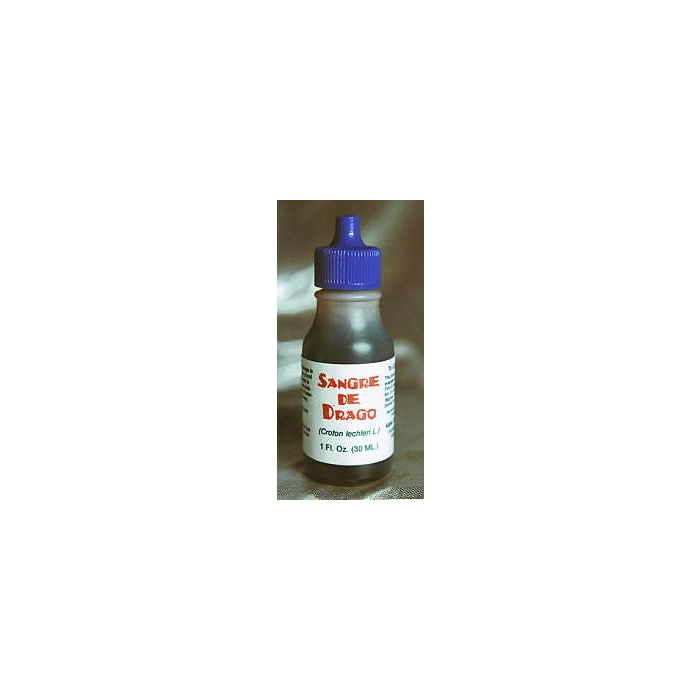Sangre de Drago - 1fl.oz
Full Description
Sangre de Drago -- or Dragon's Blood -- has been used for centuries as a wound healer, analgesic, and cancer adjuvant -- to name a few of its benefits. ( 1 ). Although it is native to parts of Africa, the Canary Islands, and Socotra -- in addition to South America, my experience is limited to the Western Amazon and the species Croton lechleri L.. In Ecuador, among indigenous peoples I have met from Orellana in the North to Loja in the South, Sangre de Drago is an indispensible healing agent among the shamans and curenderos of the Amazon region. In spending time with the Shuar, Woarani, Socoro, and numerous Quechuan speakers of the Ecuadorean orient, I have found that few tribal peoples of the Amazon do not know of this tree and its broad range of medical properties. This is probably why Dr. John Wallace of the University of Calgary's Faculty of Medicine predicted that every medicine cabinet and first aid kit in North America will one day make use of it. ( 2 )
Benefits
Sangre de Drago -- or Dragon's Blood -- has been used for centuries as a wound healer, analgesic, and cancer adjuvant -- to name a few of its benefits. ( 1 ).
Directions for Use
The following uses and protocols are well-established among the people's of the Ecuadorean orient. Please note that these are indigenous uses, few of which have gone through rigorous clinical testing. This ethnobotanical information is provided as a guideline to how others use this variation of Sangre de Drago: Insect Bites -- Pain relief comes in as little as 90 seconds and covers a broad range of insects. Itching and swelling are rapidly alleviated. Burns -- For simple first degree burns, a few drops spread lightly over the area works wonders. Sore Throat / Cough -- Sangre de Drago is anti-bacterial and anti-viral. A common use for sore throat is to take just one drop -- sublingually. For a nagging cough, a half teaspoon (2.5 ml.) twice daily in a small glass of water is usually sufficient to gain relief. Ulcers, Gastrointeritis & Other Infections of the Gastrointestinal Tract -- One half teaspoon, 3 times per day, for up to 12 days or "until cured." Urinary Track Infections -- One half teaspoon in water, one to three times a day based on severity, until eliminated. Premenstrual Cramps -- One half teaspoon with water, three times a day, for relief. Helps regulates periods. Menstrual Period Regulation -- One half teaspoon, in pure water, taken in the morning. Cancer -- For reasons that are not clear even to this author, among the many cancer remedies that are used in the Amazon, this variety of Sangre de Drago is used primarily for cancers of the reproductive organs only: prostate, testicular, and penis in men; cervical, uterine, and vaginal in women. I have been repeatedly told that this is where they are most efficacious in cancer cases. Protocol: 5 drops in a small glass of water (not juice!), three times per day. Post Eschar Anti-Scarring -- We have been experimenting with Sangre de Drago in the healing of eschars created through the use of Cansema. My interest in this stemmed from the fact that there is a greater occurrence of keloidal scarring with the use of escharotics in South America and Africa. We had some success with Tru-Derm Anti-Scar Cream prior to the FDA raid, but based on its ancient and common usage on wounds of all types to prevent scarring before it occurs, we are testing for this application now. (Incidentally, a different remedy is used in the Amazon to remove scars after they occur: Oil of Canela ("Ishpingu" in the Pastaza Quechuan dialect).
Recommended Video Short on Sangre de Drago
The following video is recommended: Harvesting Sangre de Drago -- I've harvested Sangre de Drago myself . . . so I can tell you, this 0:26 shortie gives you a glimpse of how its done in small amounts. In commercial applications, a larger vessel is set against the tree -- much as maple syrup is collected.
Footnotes
# The term "Dragon's Blood" is used as a generic identifier here, but readers should be aware that the term refers to the sap from a broad range of resin-bearing trees -- some of which are completely unrelated. The complete order / family / genus / species of our product is Dicotyledoneae euphorbiaceae croton lechleri L. -- and it is found in abundance in the Ecuadorean Amazon. The term is also used for sap obtained from monocots of European and Asian origin. A wonderful description of the varieties can be found in Jean H. Langenheim's Plant Resins: Chemistry, Evolution, Ecology, Ethnobotany (p. 441-445). Additionally, it should be noted that even among individual members of Croton lechleri L. there are varying characteristics. For instance, a tree grown next to a river will draw more water through its roots, such that when you draw the sap you get a more diluted plant resin. We found the distinctions disturbing -- especially when added to the fact the counterfeit manufacturing technique we describe above. For this reason, we use our own people to draw and process the sap. Our product is has a thicker consistency than other sangre de grado I have used and has more "medicinal" organoleptics. # Langenheim herself references the work of Pieters (1992) who "confirmed the wound-healing effect of crude Croton resin within vivo experiments with rats. A component of this dragon's blood, 4-O-dimethylcedrusin, also improved wound healing in vivo. The effect was greater with the crude resin, however, which Pieters and coworkers attributed to the additional polyphenols that precipitate cell protein and form a crust over the wound." (Pieters, L., T. de Bruyne, G. Mei, G. Lemeire, D. van den Berghe, and A.J. Vlietinck. 1992. In vitro and in vivo biological activity of South American dragon's blood and its constituents. Planta Medica 58:582-583.) [Langenheim, p. 548]. This physical property can be observed in just seconds. Place two drops on your skin and rub. You will notice that the color changes from red to a whitish pink. Within a few moments this "film" will dry and form a kind of translucent, protective "crust" over the skin. The effect has a remarkable esthetic quality to it . . . and I have observed that some indigenous women will use a small amount and apply to the face. The effect produces an ethereal "glow" that I have not observed in the ethnobotanical application of any other plant substance.





